Many ultra-lightweight backpackers carry alcohol stoves, while some won’t bother carrying a stove at all. For the rest of us, here are some considerations to keep in mind if you need to purchase a backpacking stove:
- Cost. Consider the long-term cost of owning the stove by factoring in the price on a per-use basis. The stove itself may be cheap, but take into account the operational costs, such as the fuel and any unique components.
- Durability. Look at the construction materials, ease of taking it apart to clean/replace parts, etc. Are there are flimsy plastic components that could break? The MSR whisper series receive accolades for its design & simmering ability, but many hikers complain that the plastic valves break. You don’t want to be bothered with the inconvenience of a broken stove while in the backcountry.
- Fuel. If you are planning to travel outside of North America, look for stoves that burn multiple fuels. Most stoves in North America use white gas, kerosene is standard in other parts of the world, as is unleaded auto fuel.
- Boil Time. Decide if you want a stove that produces a hot flame quickly (boils water fast), or one that has simmer capability (gourmet cooking). There are even ones that will do both.
- Waste. Look for stoves that do not have disposable parts. The propane tanks that come with the canister stoves are not recyclable or refillable. You will have to carry out the empty fuel canister and find a place to dispose of it properly. The fuel canisters are not easy to find (limited to camping stores).
- Weight. Consider not just the weight of the stove, but also the weight of the fuel canister. Decide how much weight you are willing to carry. The advantage of stoves with fuel bottles or refillable tanks is that you can take as much fuel as you need. On shorter trips, you can get by without carrying only a fuel bottle. If we top off our refillable stove, the fuel lasts 3 days, burning 2-3 meals per day.
Type of Backpacking Stoves
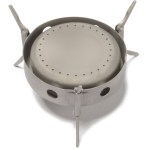
Alcohol Stove
This stove uses denatured alcohol to burn and can take anywhere from 5 – 15 minutes to boil water. These stoves are a minimal investment and attractive to DIY types because you can build them from household items. Various build designs are all over the web. A great resource is http://zenstoves.net/Stoves.htm. Make sure your design includes a wind shield. Outdoor Herbivore made a stove using a soda can and a dog-food can. Both types worked, but each one took 3+ minutes for the water to boil. We used heet, a brand of methyl alcohol as the fuel and an aluminum cook pot. Heet is available in U.S. gas stations or auto parts store. We don’t use the stove since we already have a backpacking stove that can boil water much faster. Regardless, it was fun to assemble and did work. One caution: it is difficult to see the flame when burning alcohol during the day. We scorched our hand while waving it back and forth over the invisible flame — convinced it was not lit. Also, since there is no flame control with an alcohol stove, it is either fully burning or not burning at all.
The main advantage of Alcohol Stoves is that they are very lightweight, simple to build, easy to use, and replace (recycle).
The largest disadvantage of alcohol stoves is the long boil time. When you are camping during the winter on the summit of a mountain in freezing cold temperatures, the last thing you want is to tinker with a stove and WAIT for it to boil water. When mountain trekking, nothing warms you up faster than hot fluids. This is not the right stove to choose if you are the type that enjoys drinking coffee/hot chocolate, waking up with a hot breakfast, or warming up with a hearty soup in the evening.
Canister Stove
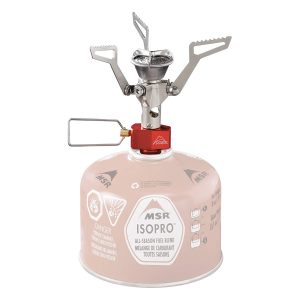
These are simple to use and provide an instant flame. The flame burns clean, so it is not likely to leave black soot on your cooking pot. Many canister stoves also come with flame control or simmer capability.
The Canister Stove is an excellent option if you don’t mind the inconvenience of purchasing and disposing of canisters.
The biggest drawback is that it does not perform well in the cold. The fuel depressurizes when exposed to temperatures at or below freezing, which could mean you are left without a flame or a very weak one. It is also not easy to check how much fuel is left in the canister. The canisters are not easy to find (limited to outdoor stores), and shipping is cost-prohibitive. Despite these drawbacks, we’ve been happy with the performance of our MSR Pocket Rocket.
Jetboil Personal Cooking System
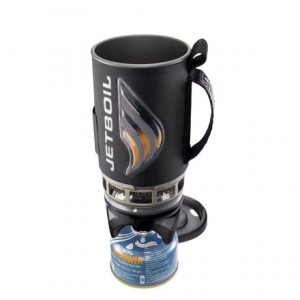
This is a type of canister stove, and it serves one primary function: to boil water quickly. This stove uses a closed design with 100% proprietary parts, even the cooking pot is integrated. If you are the do-it-yourself type, you may not like this stove. Conversely, if you are a solo hiker and like to keep it simple, you may love it.
The advantage of the Jetboil is that it is easy to use, compact, reliable, and boils water quickly (when its parts are tightly sealed together).
Don’t buy this stove if you cook for more than yourself or larger meals, want simmer capability, or don’t like the restriction of purchasing only Jet Boil’s equipment.
Multi-Use Stove
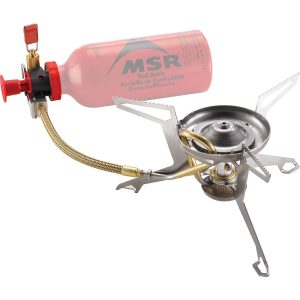
These stoves can be heavy for some, but they do perform and last. For instance, we have a 25-year-old Coleman Peak stove that continues to work, and even though the model is long discontinued, we can still purchase replacement parts for it. The design is intuitive and simple – we can take it apart in a few seconds to clean/replace a part when needed.
Multi-Use Stoves boil water quickly (2-3 mins), simmer, and can accept different fuels. This is a great stove to take if you plan to travel internationally since it can accept various types of fuel – kerosene, white gas, unleaded vehicle gas, and diesel.
The primary disadvantage is that it requires priming to start and is heavy.
Backpacking Stove Comparison Table
pros (+) and cons (-)
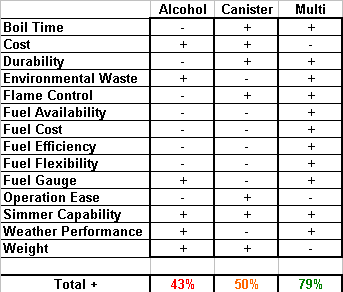
5 thoughts on “Comparing Backpacking Stoves”
These tips on what to compare to get the best backpacking stove on the market are spot on!
Not quite sure why it was stated propane canisters are not recyclable! When in fact they certainly are.
Isobutane fuel canisters can be recycled in places that accept mixed metal. Make sure the canister is empty and punctured. Contact your city/local recycling center to see if it is accepted.
How about the twig stoves ????
Wood stoves are great in wooded areas. You’ll need patience waiting for the water to boil. We will cover that in our next version of the article. Thanks for the suggestion.